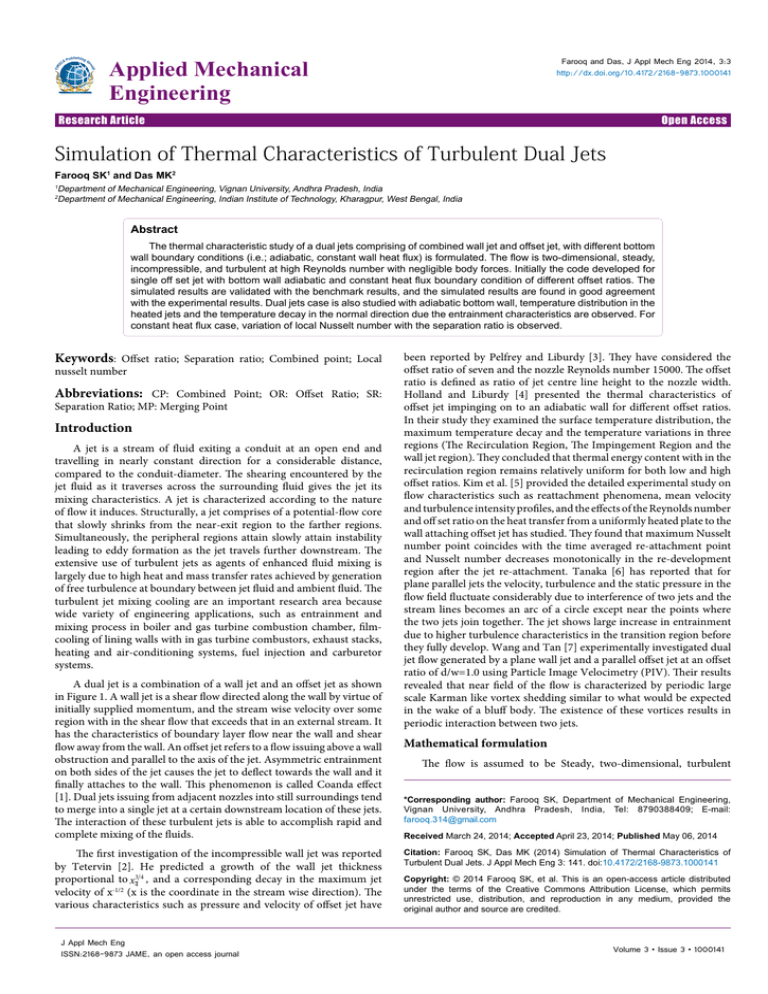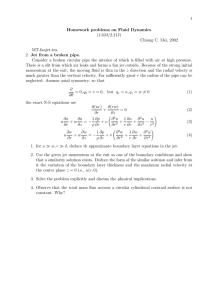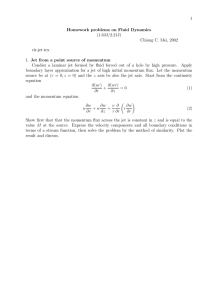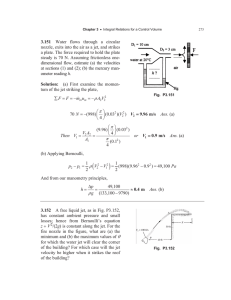advertisement

Farooq and Das, J Appl Mech Eng 2014, 3:3 http://dx.doi.org/10.4172/2168-9873.1000141 Applied Mechanical Engineering Research Article Open Access Simulation of Thermal Characteristics of Turbulent Dual Jets Farooq SK1 and Das MK2 1 2 Department of Mechanical Engineering, Vignan University, Andhra Pradesh, India Department of Mechanical Engineering, Indian Institute of Technology, Kharagpur, West Bengal, India Abstract The thermal characteristic study of a dual jets comprising of combined wall jet and offset jet, with different bottom wall boundary conditions (i.e.; adiabatic, constant wall heat flux) is formulated. The flow is two-dimensional, steady, incompressible, and turbulent at high Reynolds number with negligible body forces. Initially the code developed for single off set jet with bottom wall adiabatic and constant heat flux boundary condition of different offset ratios. The simulated results are validated with the benchmark results, and the simulated results are found in good agreement with the experimental results. Dual jets case is also studied with adiabatic bottom wall, temperature distribution in the heated jets and the temperature decay in the normal direction due the entrainment characteristics are observed. For constant heat flux case, variation of local Nusselt number with the separation ratio is observed. Keywords: Offset ratio; Separation ratio; Combined point; Local nusselt number Abbreviations: CP: Combined Point; OR: Offset Ratio; SR: Separation Ratio; MP: Merging Point Introduction A jet is a stream of fluid exiting a conduit at an open end and travelling in nearly constant direction for a considerable distance, compared to the conduit-diameter. The shearing encountered by the jet fluid as it traverses across the surrounding fluid gives the jet its mixing characteristics. A jet is characterized according to the nature of flow it induces. Structurally, a jet comprises of a potential-flow core that slowly shrinks from the near-exit region to the farther regions. Simultaneously, the peripheral regions attain slowly attain instability leading to eddy formation as the jet travels further downstream. The extensive use of turbulent jets as agents of enhanced fluid mixing is largely due to high heat and mass transfer rates achieved by generation of free turbulence at boundary between jet fluid and ambient fluid. The turbulent jet mixing cooling are an important research area because wide variety of engineering applications, such as entrainment and mixing process in boiler and gas turbine combustion chamber, filmcooling of lining walls with in gas turbine combustors, exhaust stacks, heating and air-conditioning systems, fuel injection and carburetor systems. A dual jet is a combination of a wall jet and an offset jet as shown in Figure 1. A wall jet is a shear flow directed along the wall by virtue of initially supplied momentum, and the stream wise velocity over some region with in the shear flow that exceeds that in an external stream. It has the characteristics of boundary layer flow near the wall and shear flow away from the wall. An offset jet refers to a flow issuing above a wall obstruction and parallel to the axis of the jet. Asymmetric entrainment on both sides of the jet causes the jet to deflect towards the wall and it finally attaches to the wall. This phenomenon is called Coanda effect [1]. Dual jets issuing from adjacent nozzles into still surroundings tend to merge into a single jet at a certain downstream location of these jets. The interaction of these turbulent jets is able to accomplish rapid and complete mixing of the fluids. The first investigation of the incompressible wall jet was reported by Tetervin [2]. He predicted a growth of the wall jet thickness proportional to x43 4 , and a corresponding decay in the maximum jet velocity of x-1/2 (x is the coordinate in the stream wise direction). The various characteristics such as pressure and velocity of offset jet have J Appl Mech Eng ISSN:2168-9873 JAME, an open access journal been reported by Pelfrey and Liburdy [3]. They have considered the offset ratio of seven and the nozzle Reynolds number 15000. The offset ratio is defined as ratio of jet centre line height to the nozzle width. Holland and Liburdy [4] presented the thermal characteristics of offset jet impinging on to an adiabatic wall for different offset ratios. In their study they examined the surface temperature distribution, the maximum temperature decay and the temperature variations in three regions (The Recirculation Region, The Impingement Region and the wall jet region). They concluded that thermal energy content with in the recirculation region remains relatively uniform for both low and high offset ratios. Kim et al. [5] provided the detailed experimental study on flow characteristics such as reattachment phenomena, mean velocity and turbulence intensity profiles, and the effects of the Reynolds number and off set ratio on the heat transfer from a uniformly heated plate to the wall attaching offset jet has studied. They found that maximum Nusselt number point coincides with the time averaged re-attachment point and Nusselt number decreases monotonically in the re-development region after the jet re-attachment. Tanaka [6] has reported that for plane parallel jets the velocity, turbulence and the static pressure in the flow field fluctuate considerably due to interference of two jets and the stream lines becomes an arc of a circle except near the points where the two jets join together. The jet shows large increase in entrainment due to higher turbulence characteristics in the transition region before they fully develop. Wang and Tan [7] experimentally investigated dual jet flow generated by a plane wall jet and a parallel offset jet at an offset ratio of d/w=1.0 using Particle Image Velocimetry (PIV). Their results revealed that near field of the flow is characterized by periodic large scale Karman like vortex shedding similar to what would be expected in the wake of a bluff body. The existence of these vortices results in periodic interaction between two jets. Mathematical formulation The flow is assumed to be Steady, two-dimensional, turbulent *Corresponding author: Farooq SK, Department of Mechanical Engineering, Vignan University, Andhra Pradesh, India, Tel: 8790388409; E-mail: farooq.314@gmail.com Received March 24, 2014; Accepted April 23, 2014; Published May 06, 2014 Citation: Farooq SK, Das MK (2014) Simulation of Thermal Characteristics of Turbulent Dual Jets. J Appl Mech Eng 3: 141. doi:10.4172/2168-9873.1000141 Copyright: © 2014 Farooq SK, et al. This is an open-access article distributed under the terms of the Creative Commons Attribution License, which permits unrestricted use, distribution, and reproduction in any medium, provided the original author and source are credited. Volume 3 • Issue 3 • 1000141 Citation: Farooq SK, Das MK (2014) Simulation of Thermal Characteristics of Turbulent Dual Jets. J Appl Mech Eng 3: 141. doi:10.4172/21689873.1000141 Page 2 of 5 Converging region Offset jet Combined region Merging region Potential core Jet centerline w un mp d Wall jet cp Wall boundary layer w un Figure 1: Schematic diagram of a dual jet comprising of an offset and a wall jet. and the fluid is incompressible. Body forces are neglected and the properties are assumed to be constant. Navier-Stokes equations are used for predicting Turbulent flows. Boussinesq model is used to link the Reynolds stresses to the velocity gradients. The standard k-ε model is used for calculating the turbulent viscosity ( vt ). T − T∞ u v x y ,V ,X = ,Y = ,θ = U = = Un Un w w ∆T P= ρU n2 2 2 2 vt ,n ∂U ∂V ∂U ∂V 2 + + 2 + Re ∂X ∂ Y ∂ Y ∂ X Eddy viscosity ( vt , n ): vt ,n = C µ Re The dimensionless variables are defined as: p − p0 Gn = σ t ,n = vt ,n Pr v α ε k , k n = 2 , ε n = 3 , vt ,n = t , α t ,n = t v α Un Un w Where σk = 1.0, σε = 1.30, C 1ε = 1.44, C2ε = 1.92, C µ = 0.09 [8]. Expression for local Nusselt number (Nux ) calculation: Continuity equation: Nux = ∂U ∂V + =0 ∂X ∂Y Nux = X-momentum equation: ∂ (UV ) 2 ∂X + ∂Y 2 1 1 ∂ ∂ ∂U ∂ ∂U = − P + kn + ⋅ ⋅ (1 + vt ,n ) + (1 + vt ,n ) 3 R e ∂X ∂X ∂X R e ∂Y ∂Y Y-momentum equation: ∂ (UV ) ∂X + ∂ (V ) ∂ = − ∂Y ∂Y 2 1 ∂ ∂V 1 ∂ ∂V P + 3 kn + R e ⋅ ∂X (1 + vt ,n ) ∂X + R e ⋅ ∂Y (1 + vt ,n ) ∂Y ( ∂X ) + ∂ (V θ ) = ∂Y 1 1 ∂ ∂θ ∂ ∂θ ⋅ ⋅ (1 + α t ,n ) + (1 + α t ,n ) Re⋅ Pr ∂X ∂X Re⋅ Pr ∂Y ∂Y Turbulent kinetic energy ( k n ) equation is: ∂ (Ukn ) ∂X + ∂ (Vkn ) ∂Y 1 ∂ = ⋅ Re ∂X Rate of dissipation ( ∂ (U ε n ) ∂X + ∂ (V ε n ) ∂Y vt ,n ∂kn 1 ∂ ⋅ 1 + + σ k ∂X Re ∂Y ε n ) equation: vt ,n ∂kn 1 + + Gn − ε n σ k ∂Y J Appl Mech Eng ISSN:2168-9873, an open access journal Nu= hc (Tω − T∞ ) ∗ x q x ,n × Re× Pr * ∆T ρCPU o (Tω − T∞ ) ∆T v ⋅ 1 ⋅ 1 α ρCP U 0 (Tω − T∞ ) ⋅ UoH v . Where q x ,n = q x ,n × Re× Pr θω q x ,n (θ ω heat flux at wall is taken by [9]: ) 3 1 − θ p × C µ4 × kn2 1 Prt log( EY +) + Pf k Where θω θ p temperature at the wall and at the first grid point near to the wall, and Is Pf Pee-function which is given by vt ,n ∂ε n 1 ∂ vt ,n ∂ε n εn ε 1 ∂ = ⋅ ⋅ Gn − C2ε 1 + + 1 + + C1ε σ k ∂X Re ∂Y σ k ∂Y Re ∂X kn kn Production (Gn): hc H k Where ∆T is (Tin − T∞ ) for adiabatic bottom wall condition and (Tω − T∞ ) for constant wall temperature case and qc ρc pU o for constant heat flux case. Finally Nux = Energy equation: ∂ Uθ εn Eddy diffusivity ( α t ,n ): The non-dimensional equations are: ∂ (U ) kn2 2 n 3 P 4 Pr Pf = 9.24 × r − 1 × 1 + 0.28exp −0.007 Pr Pr t t Volume 3 • Issue 1 • 1000141 Citation: Farooq SK, Das MK (2014) Simulation of Thermal Characteristics of Turbulent Dual Jets. J Appl Mech Eng 3: 141. doi:10.4172/21689873.1000141 Page 3 of 5 Validation of the Code The average Nusselt number is calculated as Nu = L 1 Nux dx. L ∫0 Numerical scheme and method of solution In this work, the non-dimensional governing equations are discretized using the Finite volume method following Patankar [10]. The power-law upwind scheme is used to discretize the convective terms and central difference scheme is used for diffusive terms to ensure the stability of the problem. To avoid the fine mesh required to resolve the viscous sub-layer near the boundary, the wall function method due to Launder and Spalding [8] has been used which is appropriate for high Reynolds number flows. The SIMPLE algorithm of Patankar [10] is followed to couple the velocity and pressure equations. The pseudotransient approach as described in Versteeg and Malalasekera [9] is used to under-relax the momentum and the turbulent equations. An under-relaxation of 0.2 is used for pressure correction equation. The detailed discretization of the turbulent kinetic energy equation and the rate of dissipation equation have been done following Biswas and Eswaran [11]. Boundary Conditions The flow of a combined wall jet and offset jet emanating into the quiescent fluid is considered. Since the governing equations are nondimensional, the boundary conditions are also non-dimensionalized and given as input to the solution. The inlets of the combined jet, Uw, and Uo represents the non-dimensional wall jet and offset jet velocities. In the present study, keeping Uw, =1.0, Uo=1.0 respectively. For the turbulent kinetic energy equation, the boundary condition at the inlets is kn=1.5I2 where I is the turbulent intensity and is equal to 0.02. For the dissipation equation, the boundary condition is εn=(kn 1.5 C µ ¾)/l where l =0.07*w is considered. For the solid wall, no slip boundary condition is considered for velocity. Neumann boundary conditions are provided for the top boundary (i.e., entrainment side) and at the ∂φ exit boundary, a developed condition of =0 is considered where ∂n φ = U ,V ,θ , kn, ε n . It has been ensured that the first grid near the wall falls in the logarithmic region, i.e., 30<Y+<100 where Y+= yuτ /ν , uτ being the friction velocity. For bottom wall adiabatic surface condition, θ=1.0 for both the jet inlet boundary condition is considered, whereas for constant heat flux case, qx=constant. 25 To validate the code developed, the computations are initially performed for adiabatic bottom wall single offset jet with offset ratio of 3 and Reynolds number 15,000 is considered. The temperature profiles at different downstream locations, along the direction normal to the bottom wall for the offset ratio 3 are shown in Figure 2. Temperature profiles are compared with experimental results of Holland and Liburdy [4] at different locations for OR=3. It is observed that the results are in good agreement with experimental results for OR=3. The local Nusselt number distributions along the bottom plate with constant heat flux, boundary condition for different offset ratios are presented in the Figure 3 at Re=39000. In general, the local Nusselt number in the recirculation region increases due to turbulent mixing processes by the recirculation bubble and reaches a maximum value at the point where the jet flow reattaches and the results are compared with Kim et al. [5]. The computed results have been compared and found to be in good agreement with the experimental results. Results for Dual Jet The present computation study can be briefly classified in to two cases for dual jet. First case is the adiabatic bottom wall condition and second case is the constant heat flux boundary condition. For the second case, heat transfer study is carried out for local Nusselt number distribution along the bottom wall. Average Nusselt number with varying the effect of separation ratio (2.0, 2.5, 3.0) at different ranges for a constant Prandtl number (Pr=0.71) and Re=15000 respectively. Adiabatic bottom wall case Figure 4 shows the temperature distribution for the dual jets where the bottom surface is adiabatic. Since the surface is adiabatic the thermal energy distribution is a result of the entrainment characteristics of the jet with its surroundings. Near to the inlet of the two jets, in the region between the two jets and near to the surface of the bottom wall, the temperature remains in almost uniform and heated condition. In the direction normal to the surface of the plate, thermal energy decay of the jets at different locations along the stream wise direction is shown in Figure 5. 25 20 20 Present aom putation Holland and Liburdy 15 Present aom putation Holland and Liburdy 15 10 10 5 5 0 0 0.2 0.4 0.6 Temperature (a) X=0.45 0.8 1 0 0 0.2 0.4 0.6 Temperature 0.8 1 (b) X =4.42 Figure 2: Comparison with experimental results of Holland Liburdy [4] of different temperature Profiles at different location for adiabatic bottom wall boundary condition. J Appl Mech Eng ISSN:2168-9873, an open access journal Volume 3 • Issue 1 • 1000141 Citation: Farooq SK, Das MK (2014) Simulation of Thermal Characteristics of Turbulent Dual Jets. J Appl Mech Eng 3: 141. doi:10.4172/21689873.1000141 Page 4 of 5 300 Present com putation Kim et al. 250 300 250 NUX NUX 150 150 100 100 50 50 0 Kim et al. Present com putation 200 200 0 5 10 X 15 20 0 0 5 (a) OR = 2 10 X 15 20 25 (b) OR = 7 Figure 3: Comparison of Local Nusselt number with experimental results of Kim et al. [5] for bottom wall constant heat flux boundary condition. 7 X=5 X=10 X=15 X=20 6 5 Y 4 3 2 1 0 0 0.2 0.4 0.6 Temperature 0.8 1 Figure 4: Temperature distribution for Dual Jet. Figure 5: Temperature profiles at different locations along stream wise direction. Constant heat flux bottom wall case with variation of separation ratio entrainment characteristics are observed and for the constant heat flux case, variation of local Nusselt number with the separation ratio by maintaining same Reynolds number and velocities for both the jets. Increase of separation ratio parameter has considerable effect on the heat transfer characteristics on the bottom wall. As separation ratio is increased, Nux is increased for cases, but no change in the behavior is observed. Separation ratio is the center line distance between the wall jet and offset jet to the width of the jet. By increasing the separation ratio, merging point of the dual jet shifts towards the downstream direction and from the Figure 6 it can be observed that high heat transfer peaks at that point due to increase of turbulence and mixing of jets in the flow field. From the Table 1 it is observed that percentage increase in is increased for the constant wall heat flux with the increase of separation ratio. Conclusion The heat transfer study of combined wall jet and offset jet flow is carried out for different bottom wall boundary conditions. For the adiabatic bottom wall, temperature distribution in the heated dual jets and the temperature decay in the normal direction due the J Appl Mech Eng ISSN:2168-9873, an open access journal Nomenclature P¯ Static Pressure p¯0 Ambient Pressure U¯ Non Dimensional Velocity In X Direction V¯ Non Dimensional Velocity In Y Direction Nu Average Nusselt Number C1ε C2ε Turbulent Model Constants Volume 3 • Issue 1 • 1000141 Citation: Farooq SK, Das MK (2014) Simulation of Thermal Characteristics of Turbulent Dual Jets. J Appl Mech Eng 3: 141. doi:10.4172/21689873.1000141 Page 5 of 5 θ¯ Non Dimensional Temperature νt, ν Turbulent and Laminar Kinematic Viscosity ΔT Reference Temperature Difference ε Dissipation Subscripts ∞ Ambient Conditions n Non Dimensional Value o Offset Jet w Wall Jet References 1. Tritton DJ (1977) Physical fluid dynamics. Von Norstrand Reinhold, United Kingdom. 2. Tetervin N (1948) Laminar flow of a slightly viscous incompressible fluid that issues from a slit and passes over a flat plate. NACATN. 3. Pelfrey JR, Liburdy JA (1986) Mean flow characteristics of a turbulent offset. Journal of Fluids Engineering, Transactions of the ASME 108: 82-88. Figure 6: omparison of N ux for different separation ratios for constant heat flux boundary condition. 4. Holland JT, Liburdy JA (1990) Measurement of thermal characteristics of heated off set jets. International Journal of Heat and Fluid Flow 33: 69-78. 5. Separation ratio Nu % increase 2.0 29.34 2.5 30.35 3.44 3.0 31.37 6.91 Table 1: Comparison of Average Nusselt number Nu for different separation ratios. N ux Local Nusselt Number P rt Turbulent Prandtl Number qx,n Non Dimensional Heat Flux T∞ Free Stream Temperature Un Reference Jet Inlet Velocity Uo Inlet Offset Jet Velocity Uw Inlet Wall Jet Velocity D Distance between Two Jets K Turbulent Kinetic Energy Pr Prandtl Number Re Reynolds Number w Width of the Jets Kim DS, Yoon SH, Lee DH, Kim DH (1996) Flow and heat transfer measurements of wall attaching o set jets. International Journal of Heat and Fluid Flow 39: 2907-2913. 6. Tanaka E (1970) The interference of two dimensional parallel jets-First report, experi- ments on dual jets. Bull JSME 13: 272-280. 7. Wang X, Tan S (2007) Experimental investigation of interaction between a plane wall jet and a plane offset jet. Exp Fluids 42: 551-562. 8. Launder BE, Splading DB (1974) The numerical computation of turbulent flows. Computer Methods in Applied Mechanics and Engineering 3: 269 289. 9. Versteeg HK, Malalasekera W (1996) An Introduction to Computational Fluid Dynamics. The Finite Volume Method. Longman, London. 10.Patankar SV (1980) Numerical heat transfer and fluid flow. Hemisphere, New York. 11.Biswas G, Eswaran V (2002) Turbulent Flows: Fundamentals, Experiments and Modelling. Narosa Publishing house. Submit your next manuscript and get advantages of OMICS Group submissions Unique features: X Y Non Dimensional Co-Ordinates X, Y Dimensional CoOrdinates • • • Greek Symbols Special features: αt, α Turbulent and Laminar Diffusivity Citation: Farooq SK, Das MK (2014) Simulation of Thermal Characteristics of Turbulent Dual Jets. J Appl Mech Eng 3: 141. doi:10.4172/2168-9873.1000141 J Appl Mech Eng ISSN:2168-9873, an open access journal • • • • • • • • User friendly/feasible website-translation of your paper to 50 world’s leading languages Audio Version of published paper Digital articles to share and explore 350 Open Access Journals 30,000 editorial team 21 days rapid review process Quality and quick editorial, review and publication processing Indexing at PubMed (partial), Scopus, EBSCO, Index Copernicus and Google Scholar etc Sharing Option: Social Networking Enabled Authors, Reviewers and Editors rewarded with online Scientific Credits Better discount for your subsequent articles Submit your manuscript at: http://www.omicsonline.org/submission Volume 3 • Issue 1 • 1000141



